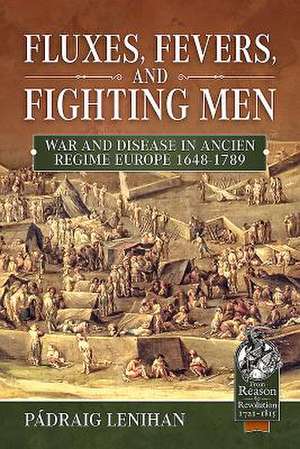Fluxes, Fevers and Fighting Men: Reason to Revolution
Autor Pádraig Lenihanen Limba Engleză Hardback – oct 2019
As plague began to recede from Europe, this study explains what exactly were these 'fluxes and fevers' that remained to afflict European armies in wartime and argues that they formed a single seasonal continuum that peaked in late summer. The isolation and incarceration of the military hospital characterized the response of the new armies to 'disorder' and to revivified notions of contagion. However, the hospital often prolonged the late summer morbidity/mortality spike into mid-winter by generating 'hospital fever' or typhus, the lice-borne disease that erupted whenever the cold, wet, hungry, transient, and unwashed huddled together. The cure was the disease.
This scope of the study includes French army operations in some of its contiguous campaigning theaters, north Italy (1702 and 1734), the Rhineland (1734), Roussillon (1674), possibly Catalonia (1693), and, further afield, Bohemia (1742). The study also includes three case-studies involving the British army that include Ireland (1689), Portugal (1762), Dutch Brabant (1748), and the Rhineland (1743). The outliers are studies of Habsburg operations in and around Belgrade (1717 and 1737), and Russian operations in Crimea (1736).
Preț: 242.84 lei
Nou
Puncte Express: 364
Preț estimativ în valută:
46.47€ • 48.62$ • 38.60£
46.47€ • 48.62$ • 38.60£
Carte disponibilă
Livrare economică 13-27 martie
Livrare express 26 februarie-04 martie pentru 50.29 lei
Preluare comenzi: 021 569.72.76
Specificații
ISBN-13: 9781911628514
ISBN-10: 1911628518
Pagini: 176
Ilustrații: 30 b/w maps & graphs
Dimensiuni: 160 x 239 x 15 mm
Greutate: 0.8 kg
Editura: HELION & COMPANY
Seria Reason to Revolution
ISBN-10: 1911628518
Pagini: 176
Ilustrații: 30 b/w maps & graphs
Dimensiuni: 160 x 239 x 15 mm
Greutate: 0.8 kg
Editura: HELION & COMPANY
Seria Reason to Revolution
Descriere
The proportion of wartime soldiers dying of disease as against combat injury, ran at about 70-75 percent in armies campaigning in Europe in the century and a half (1648-1789) between the end of the Thirty Years War and the French Revolution. Field armies doubled in size during this period and regimes usually fought for limited territorial gains, so













